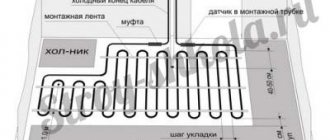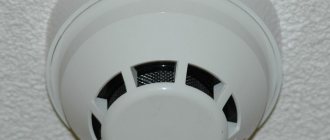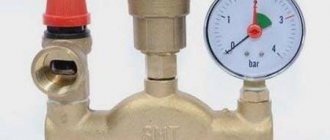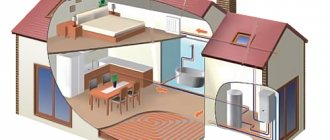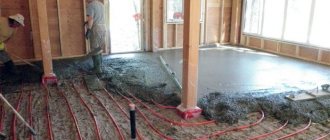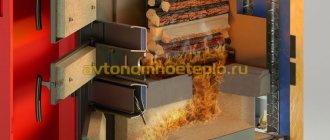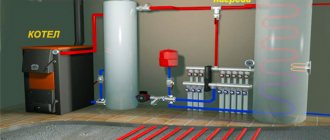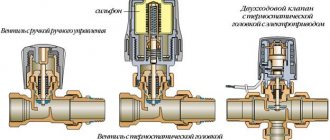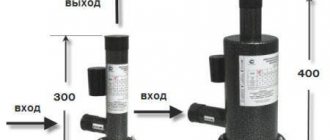Convector heating, its features and operating principle
The operating principle of convector heating is based on the properties of air masses. Heated air is lighter than cold air, so it always rises. After cooling, the air masses descend to the lower part of the room and are heated again when passing through the convector.
The main advantage of convector heating is the rapid heating of the room and maintaining the desired temperature throughout the entire operating time of the device. Convectors are suitable for heating residential and commercial premises.
The operating principle of convector heating is as follows:
- Inside the heating device there are heating elements with a significant surface area. They heat up when using certain energy resources.
- When air comes into contact with the heater area, it warms up and becomes lighter.
- The heated air exits through the convection holes at the top of the radiator and rises.
- After cooling, the air masses descend to the lower part of the room and again enter the heating device through the slots in its lower part. This circulation continues while the device is operating.
Types of convector heating and connection nuances
The convector connection diagram depends on its type. There are electric, water and gas units. The first ones operate on AC power. To use water heating, you need to connect the radiator to a centralized or autonomous heating system with liquid coolant. Gas convectors operate on liquefied or main gas.
Important! A reflective screen is used to improve heating efficiency. When installed on the wall behind a heating device, the screen reflects thermal energy back into the room and does not allow heat to escape through the building envelope.
Installation of water convectors
This option is traditionally used in many apartment buildings and private buildings, because it allows you to heat several rooms at once and maintain the same temperature in them. Heating devices are connected to the distribution of autonomous or centralized heating.
Electric heating elements with thermostat for heating boilers and radiators
Water convectors use water or antifreeze as a coolant. In an autonomous system, a solid fuel, electric or gas boiler is installed to heat the coolant.
Important! Room temperature regulation is achieved by adjusting the boiler or by installing a thermostat and control valve on each radiator. Mayevsky valves are installed to release air.
The installation of heating convectors operating with liquid coolant depends on the type of unit.
There are the following types of water convectors:
- Wall-mounted radiators are mounted under the windows of the room on special brackets to create a thermal curtain. The device is connected to the pipe distribution, and after checking the tightness of all connections, it is started.
- In-floor convectors are installed in special niches in the floor and covered with durable grilles on top. They are similarly connected to the pipe distribution, which is laid in the floor screed during its installation.
- Floor radiators are installed on special stands included in the kit. The legs are rigidly attached to the floor to ensure safe operation of the device. Typically, a bottom convector connection and hidden piping under the floor are used.
- Skirting water convectors are mounted near the floor along the walls of the room. They are attached to the walls on small brackets and covered with a protective casing on top. When connecting them, special fittings are used. Pipes to baseboard radiators must be laid in advance at the stage of installing the floor screed.
Connecting a gas convector
The gas convector is connected to main gas supply networks, gas cylinders or gas holders. To connect to the main line, you need to prepare a project, approve it with the gas service, and obtain permission. You do not need to obtain any permits to use bottled gas.
The air in the room heats up when it comes into contact with the heated body of the device. It, in turn, is heated by the thermal energy released during the combustion of fuel in the combustion chamber. In the same chamber, the necessary gas-air mixture is formed.
The advantage of gas convectors is the low cost of fuel, but due to the impressive dimensions of the device and the complexity of the connection, these units are rarely used. The main disadvantage of installation is that you will have to make a hole in the outer wall of the house to remove combustion products.
Gas heating convectors for home and their design
Installation of a gas convector in a wooden house or building made of other materials is carried out as follows:
- For floor installation, you need to prepare legs made of steel pipe. Wall installation is carried out using special brackets. They must be fixed to the wall of the room in advance.
- We make a hole in the outer wall at the required height for the coaxial chimney. Its diameter should be 10 cm larger than the diameter of the pipe.
- A reflective screen made of non-flammable material is fixed to the wall.
- The heater is mounted on the wall of the room using brackets. Its coaxial chimney is discharged into a hole in the wall. The cracks around the pipe are sealed with non-flammable material, and the outside is covered with a solution.
- The convector is connected to a gas cylinder or main pipeline.
Advice! For proper installation of a gas convector, it is better to contact a professional technician, and the connection to the gas main is carried out only by employees of the relevant service.
Electric convectors and their connection
These units are very popular because they are easy and quick to install and connect. They are mobile, so the heating device can be moved from one room to another and installed anywhere. The main thing is that there is a working AC power nearby. There are floor and wall-mounted electric convectors on sale. Their main drawback is the high cost of energy.
Connecting a floor heating convector powered from the mains is the easiest way. It is enough to install the wheels or stands for the device included in the kit and connect the unit to the AC mains. Thanks to automatic or mechanical control, you can regulate the air temperature in the room. Convectors with a built-in thermostat switch themselves off when the desired air temperature is reached and automatically turn on when it drops below the set value.
Important! Units with a thermostat save up to 10 percent of electricity.
Connecting VITRON convectors. Regulation
Connecting direct heating convectors
Connection of convectors and regulation is an integral part of every heating system and has a significant impact on the overall parameters of the heating system.
In electric heating systems this is doubly important; poorly adjusted regulation can have a huge negative impact, first of all, on the cost of operation. Although standard direct heating convectors are equipped with thermostats (electronic or electromechanical), the built-in thermostats require time programming, and without appropriate higher-level regulation they only interfere with the overheating of the room. Without higher-level regulation, the convector operates almost continuously, regardless of the presence or complete absence of inhabitants in the house.
A practical example is the situation that developed in 1990-1994, when there was a powerful campaign in support of electric heating, which also “guaranteed” low prices for electricity. The campaign led to mass installation of direct heating heaters, but in the vast majority of cases without appropriate regulation. An unexpected increase in the cost of electricity affected such heaters with a significant increase in the costs of their operation, which logically led to the opposite effect, that is, to a massive abandonment of direct heating systems with convectors.
Ultimately, electric heating for a long time undeservedly gained a reputation as a comfortable, but disproportionately expensive heating system.
Currently, not only the technical level of buildings and structures is constantly increasing, but also the awareness of builders in these issues, and accordingly, the share of electric heating systems in finished buildings is constantly increasing. Direct heating convectors belong to convection heating systems, therefore regulation is based on the air temperature in the heated room.
Since direct heating convectors cannot quickly change the power, but can only alternate between on/off modes, in this case regulation in relation to the outside temperature does not matter. This is the so-called equithermal regulation is only suitable for heating systems that can change their output depending on demand - a typical example is a water heating system in which, depending on the outside temperature, the temperature of the heating water is set by mixing. In practice, regulating the operation of convectors in accordance with the indoor temperature can be done in two ways:
a. Regulation via room thermostat
b. Setting the attenuation mode using the control wire
Controlling the convector using a room thermostat
This method of regulation in the Czech Republic is one of the most common and familiar. A digital room thermostat is installed in the heated room, which records the air temperature and, in accordance with the configured program, turns on or off the connected heater, maintaining the desired temperature in the room.
Since the temperature in the room is fixed by a higher-level thermostat, the connected convector must be in the on mode throughout the entire heating season, and the thermostat built into it must be set to maximum so that both adjustments do not mutually influence each other. When applying this type of regulation, some basic rules must be followed.
- digital programmable control is used, which allows you to select an operating program. Correctly configured operating mode, i.e. when to bring the heating to a comfortable temperature, and when to just maintain it, determines the path to economical heating. Using analog thermostats without the ability to program the mode does not make any sense, since they perform the same function as the thermostat built into the convector, and thus its installation is unnecessary.
- Each room should have its own thermostat (or central control sensor), which is regulated separately. A system of one thermostat, which records the temperature in the control room (usually used for gas boilers) and, based on the measurements obtained, turns on/off the heaters in all other rooms, is absolutely unacceptable for combination with electric heating.
- The placement of the thermostat/temperature sensor must meet the accepted temperature control requirements, i.e. The thermostat/sensor should be installed on an internal uncooled wall, at a height of approx. 1.2 m above floor level, without possible influence of direct solar radiation or other source of heat/cold
- You should not exceed the value of the closing contact in a programmable thermostat and, as a rule, (if technically possible) it is more advisable to use the thermostat to close only the power contact in the distribution box (contactor). This extends the life of the thermostat and battery for program backup, and the thermostat operates more accurately, since it is not heated by the current flowing through the closed contact. Regulation of the attenuation mode through the control wire
Regulation of convectors using the so-called. The control wire is used mainly abroad, in particular in France, where there is a long tradition of production and use of electric convectors for heating purposes.
In essence, we are talking about central regulation, in which convectors are regulated from one center, but at the same time each room maintains its own temperature - from this point of view, this is one of the simplest and at the same time the cheapest methods of central regulation.
The principle of central regulation is that the room temperature is adjusted and maintained using a thermostat built into the convector. Built-in thermostats, having received an impulse through the control wire, are capable of reducing the room temperature by 4°C without the help of personnel (in the so-called damping mode) compared to the set comfort temperature. With a second impulse, the thermostat returns to the comfort temperature.
Thus, in convectors in each room the temperature is set corresponding to its purpose and consumer requirements.
The control wires from all convectors will be connected to attenuation mode regulators (essentially, temporary switches), in which the time of sending an impulse to lower the room temperature to the energy-saving mode temperature is set, as well as the time of sending the next impulse to return to the comfort temperature. Attenuation mode regulators, as a rule, allow you to divide the heated object into two or three zones, and set your own time mode for each zone.
Control wires from convectors located in rooms in which it is necessary to simultaneously achieve a comfort temperature (zone) are connected to one output of the attenuation mode regulator, and heaters in rooms with a different time mode (second zone) are connected to the second output.
In practice, this means that the premises on the first floor of a family cottage (office, dining room, kitchen, corridors) can be heated to a comfortable temperature at a time different from the heating time of the premises on the second floor (living rooms, children's rooms, bedrooms), where the inhabitants of the house will move in the evening.
Switching between two temperature values is also sufficient, and setting the temperature decrease by more than 4°C in principle does not make sense, since to then achieve a comfortable temperature in the facility will require much greater energy costs than the costs of maintaining it throughout the entire time at a slightly higher temperature level.
Modern new buildings, in addition, have such good thermal and technical characteristics that if the consumer does not specifically “ventilate”, then in normal operation the temperature cannot spontaneously drop by more than 4°C. When regulating the attenuation mode through the control wire, the advantage of convectors with an electronic thermostat increases fundamentally.
Unlike convectors with an electromechanical thermostat, they are not only more accurate and silent, but thanks to precise switching, the temperature of the exhaust air is lower, which allows for more economical operation and reduces the risk of ignition of dust particles. The surface temperature of the convector is also lower, which increases its service life.

